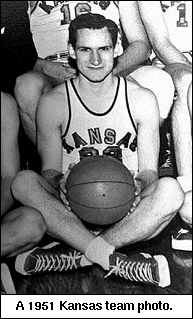 Even then, he was coaching up a storm
on the sidelines. He didnıt have any choice.
Even then, he was coaching up a storm
on the sidelines. He didnıt have any choice.
Smith the player was small, slow
By STEVE ELLING
The News & Observer
 Even then, he was coaching up a storm
on the sidelines. He didnıt have any choice.
Even then, he was coaching up a storm
on the sidelines. He didnıt have any choice.
You see, Dean Smith didn't get much playing time.
Funny as it sounds, the guy who has more victories than any coach in NCAA history didn't make much of a dent as a player.
More accurately, the newly crowned king of college bench coaches got his start on the sideline pine.
Smith was buried so deep on the bench of Kansas' national championship team in 1952 that he and his teammates used to talk strategy while the game was in progress.
"We used to discuss what could be changed to make the team better," said B.H. Born, a former Smith teammate. "Heck, neither of us played much until the game was decided."
There's long been a notion that players who ride the bench often make good coaches later. Something to do with soaking up the game's nuances, listening to the coaching analysis, watching how matters develop on the floor.
As for whether time on the bench makes a guy a better player, well, Smith doesn't think so. He ought to know, since he averaged two points per game as a sub in his playing days.
"Hah, no, not at all," Smith harrumphed this month. "It's easier to get in the flow when you're actually on the floor."
Smith often was on the floor just the wrong part of it. Players were forced to work for their scholarships in those days, and Smith helped coached the raw-boned kids on the KU freshman team.
Or, as Smith cracked, "I was coaching football players when I wanted to be down there with the varsity."
Truth be told, there were a couple of problems therein. Born said this tends to be pointed out at Smith's expense every few years at team reunions, with considerable hilarity.
Namely, that Smith was, ahem, too small and too slow. Worse, Smith has groused several times lately that he was no leaper, either. We just described the prototype ... coach.
Athletically caught short, so to speak, Smith quickly developed an affinity
for the cerebral side of the game.
Smith this month recalled an incident in which he jump-started his coaching career in less-than-glorious fashion while still riding the varsity pine at ol' KU.
| Those who have followed Dean Smith know the coach has an aversion to
statistics. One of his least favorite things, in fact, is fansı
preoccupation with scoring averages and the like. In his two years on
the varsity at Kansas, Smith never averaged more than two points per
game. Smith had 25 field goals at KU, which played in the NCAA
championship games both seasons.
1951-52 season 1952-53 season |
Kansas was in a team meeting when the coach, Dr. Phog Allen, ordered his troops to run a certain style of offense. Smith was surprised at the coach's decision and piped up.
"Run the weave against a zone?" Smith said.
At split-second later, at least one dirty look was shot in his direction.
"Shut up, Smith," an assistant barked tersely.
Born said that one of the most amusing things about Smith was that he believed he was a good shooter and constantly challenged more established twin teammates Allen and Dean Kelley to shooting contests. Games were another story.
"Once he got on the floor, he didn't put it up much," said Born, who was a year behind Smith in school and later became a KU star.
According to Kansas records, Smith made 27 of 48 free throws (56.3 percent) in his two seasons. No records were available for his field-goal percentage, though Smith scored 25 field goals in his two years on the varsity.
Smith was a good ballhandler, Born said, who played fierce defense. Kansas was one of the first teams to run a full-court press, and Smith's teams at UNC have been known for their ever-evolving defenses. Last weekend in the ACC Tournament final, Smith put 7-foot-3 center Serge Zwikker on a 6-foot point guard.
"He was always talking about defense," Born said. "It was one of his [favorite] things."
While Smith wasn't a star at Kansas, his teams were solid. The Jayhawks won the 1951-52 NCAA championship in his junior season and lost to Indiana in the final in '53. Smith played briefly in both games and scored one point in the latter.
Alas, Smith's lot in life at KU was as a sub. Then again, there are 23 players in the KU team photo from the '52 team, so he had plenty of company.
By his senior year, Smith worked his way into a prominent reserve role and played in every game on a overachieving team that finished 19-6, yet scrapped its way into the NCAA final before losing to Indiana 69-68.
A few more numbers from Smith's playing past: As a junior, he wore jersey No. 33. A year later, he switched to No. 22.
Of course, after moving past Adolph Rupp by beating Colorado on Saturday, Smith now wears No. 877.